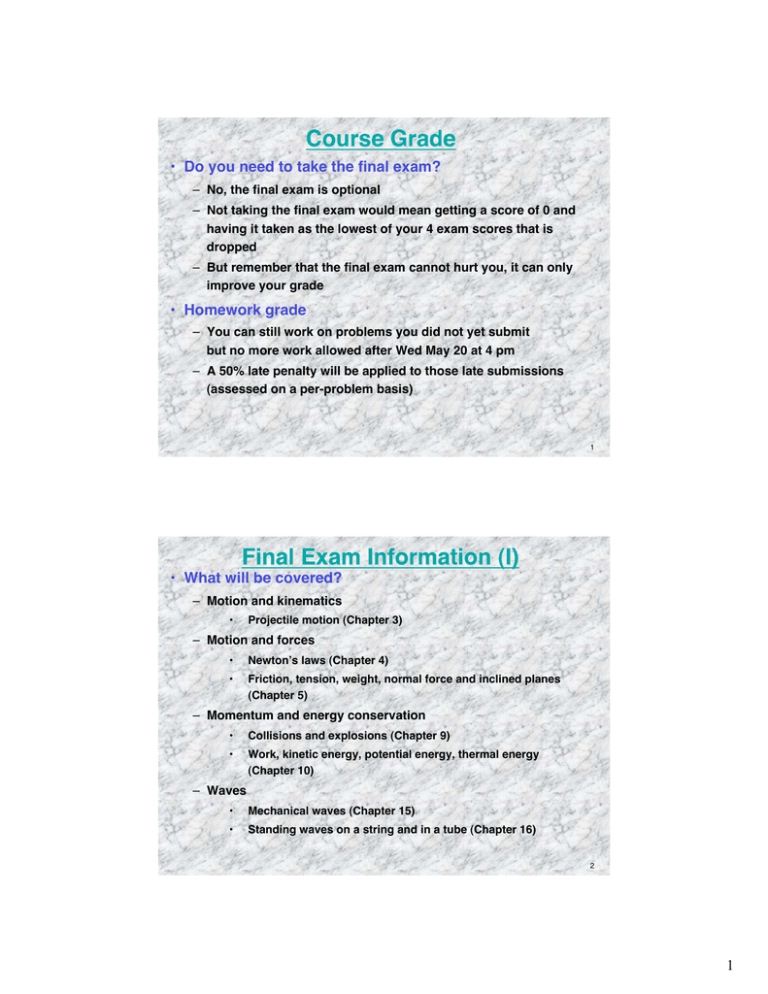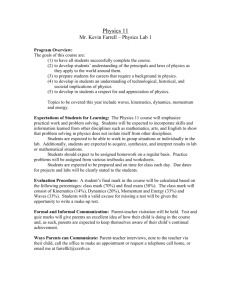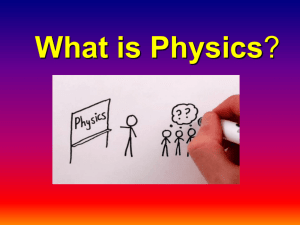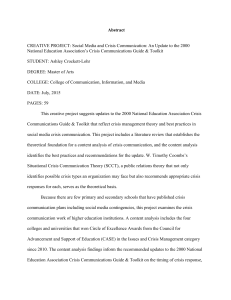• Do you need to take the final exam? • Homework grade • What will
advertisement

• Do you need to take the final exam? – No, the final exam is optional – Not taking the final exam would mean getting a score of 0 and having it taken as the lowest of your 4 exam scores that is dropped – But remember that the final exam cannot hurt you, it can only improve your grade • Homework grade – You can still work on problems you did not yet submit but no more work allowed after Wed May 20 at 4 pm – A 50% late penalty will be applied to those late submissions (assessed on a per-problem basis) 1 • What will be covered? – Motion and kinematics • Projectile motion (Chapter 3) – Motion and forces • Newtons laws (Chapter 4) • Friction, tension, weight, normal force and inclined planes (Chapter 5) – Momentum and energy conservation • Collisions and explosions (Chapter 9) • Work, kinetic energy, potential energy, thermal energy (Chapter 10) – Waves • Mechanical waves (Chapter 15) • Standing waves on a string and in a tube (Chapter 16) 2 1 • What is not covered? – Apparent weight – Gravitational force – Center of gravity and Torque – Temperature and Heat – Oscillations 3 • Exam format – Multiple choice (no written problem) – Mixture of conceptual questions (PRS like) and numerical problems (homework like) – Sample exam provided for practice (sample exam will be discussed during the special help session) • Grade – Lowest score on the 4 exams will be dropped your grade can only improve with the final exam! 4 2 • Exam on Thursday May 14 from 1:30 to 3:30 pm – Boyden Gym (upstairs) Physics 131 5 • What to take to the exam? – Bring calculator, #2 pencil, student ID + hand-written formula sheet (filled on both sides) – No scratch paper (should not be needed) – No book • Resources – Help session on Wednesday May 13 from 2:00 to 4:00 pm in HAS 20 – Sample exam + previous exams + homework + lecture notes + textbook problems (answers to odd-numbered problems are in the back of the book) 6 3 Final Exam: units Use SI units Generally need to convert all quantities to SI units distance unit: mass unit: time unit: force unit: momentum unit: energy unit: m kg s N (or kg m/s2) kg m/s J (or kg m2/s2) Conversions 1 km = 103 m 1 cm = 10-2 m 1 mi = 1600 m 1 gram= 10-3 kg 1h = 3600 s 1 min = 60 s 1 lb = 4.45 N 360o = 2 radians 7 Final Exam: vectors & concepts Work with x- and y-components, and angle Know and understand main concepts in the lecture notes Newton’s laws, momentum, energy, work, collisions, waves 8 4 Final Exam: Equation toolkit (v x ) f = (v x ) i + axt Motion kinematics valid only if constant acceleration btw initial time ti and final time tf 2 2 (v x ) f = (v x ) i + 2axx x f = x i + (v x ) i t + 12 ax (t ) 2 Projectile 2D motion ax = 0 and ay = -g (v x ) f = (v x ) i x f = x i + (v x ) i t (v ) = (v ) gt (v ) = (v ) 2gy y = y + (v ) t g(t ) y f y i 2 2 y f y i f i y i 1 2 2 Compute t to relate motion along x-axis to motion along y-axis If y is given, generally compute t from y-motion If x is given, generally compute t from x-motion 9 Final Exam: Equation toolkit Forces and motion acceleration is the link between forces and motion If given forces acting on an object: 1. 2. 3. 4. Newton’s 2nd law F F x = max y = may Identify forces & draw free-body diagram Compute net force along x and y axes (or just 1 axis as required) Compute corresponding acceleration using Newton’s 2nd law Use kinematics equations (previous slide) to determine the change in motion (e.g. find final position, velocity, etc.) If given information about motion (e.g. displacement x, time interval t, initial and/or final velocities): 1. 2. Use kinematics equations and motion information to compute the acceleration Compute magnitude and direction of net force using Newton’s 2nd law 10 5 Final Exam: Equation toolkit Different forces 1. Tension T directed along a string or rope 2. Weight w=mg 3. Normal force n perpendicular to surface of two objects in contact (n = m g not true in general, true only in special cases) 4. Friction fs max = μs n fk = μk n static kinetic 11 Final Exam: Equation toolkit Impulse (J) and Momentum (p) remember these are vector quantities important to keep track of direction (negative for motion to the left) J = p f pi = p Before p = mv m: mass of object v: velocity of object After 12 6 Final Exam: Equation toolkit Collisions and Explosions analyze with momentum conservation (p is vector quantity!) can apply momentum conservation if system is isolated or if external forces can be neglected during brief moment of collision typical cases: 1. collision between two objects 2. explosion into two parts (Pi = 0 if “exploding” object is at rest) 13 Final Exam: Equation toolkit Energy • A system is characterized by a total energy E E = K + Ug + Us + Eth + Echem + … • Energy is conserved if system is isolated, or E = W+Q K + Ug + Us + Eth + … = W + Q 14 7 Final Exam: Equation toolkit Energy • Kinetic energy K = 12 mv 2 • Gravitational potential energy U g = mgy • Spring potential energy U s = 12 kx 2 Work done by force F: Ei = mgh W = Fd cos Energy conservation leads to: h vf v f = 2gh Ef = mvf2 15 Exam 3: Equation toolkit Collisions • Perfectly elastic: momentum and mechanical energy is conserved • Perfectly inelastic: (objects “stick” together after the collision) Pi = Pf Ki + Ui = K f + U f Pi = Pf only momentum is conserved 16 8 Final Exam: Equation toolkit Waves Periodic disturbances propagating through medium transfer energy but not matter (electromagnetic waves like light do not need medium) 1. Wave source determines amplitude A, frequency f period T 2. Medium determines speed v = f = / wavelength 17 Final Exam: Equation toolkit Standing Waves String with fixed ends, and open-open or closed-closed tube oscillate at fixed resonant frequencies that depend on the string or tube length L 2L m = m m = 1,2,3,4,... v f m = m 2L 18 9 Final Exam: Equation toolkit Standing Waves Open-closed tube oscillates at fixed resonant frequencies that depend on the tube length L 4L m v f m = m 4L m = m = 1,3,5,7,... Useful to know: wave speed on string with tension Ts and Ts mass per unit length μ v= μ 19 10



